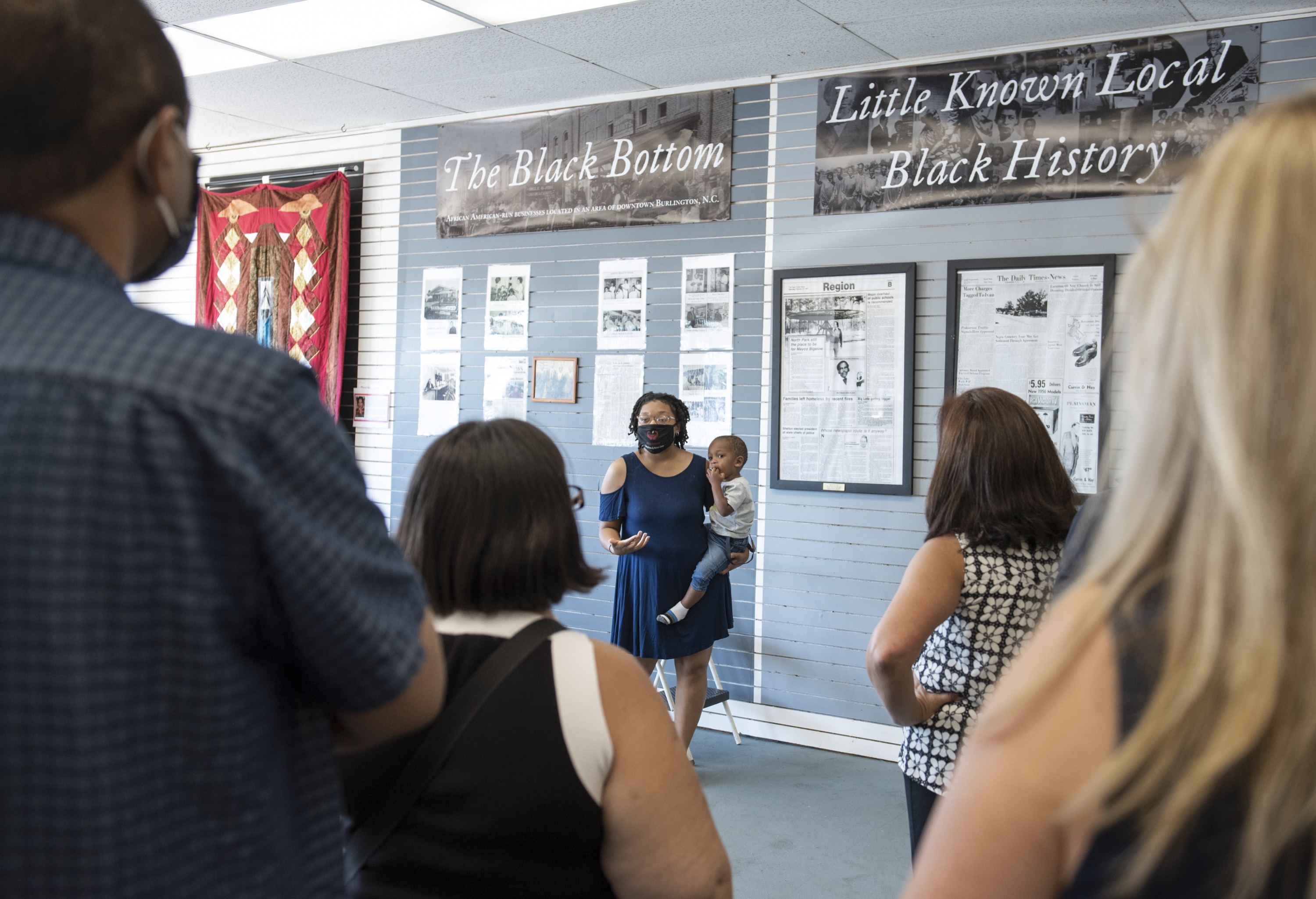The tours for members of the Elon University community on Friday, June 18, were organized by Elon's Center for Race, Ethnicity and Diversity Education to recognize and celebrate the Juneteenth holiday this year.
Members of the Elon University community on Friday gained insight into Black history in Alamance County during tours of the African-American Cultural Arts & History Center in Burlington.
Organized by Elon’s Center for Race, Ethnicity & Diversity Education (CREDE), the tours led by Shineece Sellars, executive director of the Burlington center, highlighted the struggles, successes and impact of Black residents of the county, with a primary focus on the period following emancipation. The tours were planned as the community looks toward Juneteenth on Saturday, a holiday that celebrates the emancipation of those who had been enslaved in the United States. Juneteenth became a federal holiday this week following legislation passed by Congress and signed by President Joe Biden.

John Robinson-Miller IV, assistant director of the CREDE, said it is important to recognize Juneteenth in ways that are both educational as well as celebratory. “It’s a holiday that has been celebrated for many years, but in recent years there is increased awareness about what it is and how to celebrate it,” Robinson-Miller said. “The history we are talking about with Juneteenth is still impacting us today.”
During the three tours on Friday, Elon students, faculty and staff took a deeper dive into the lives of Black residents of Alamance County following the Civil War and emancipation. The center grew out of the genealogical work of Jane Sellars, whose research into the history of her own ancestors broadened into the exploration of Black history in the county. Last year, the center moved into a new site on Corporation Parkway and is filled with much of the work of Sellars who passed away in 2019. Shineece Sellars is her daughter and is carrying on her work as executive director of the center.
The focus of the center’s exhibits is extremely local rather than exploring larger moments or movements in Black history such as the impact of Martin Luther King Jr. or slavery, Sellars said. “The goal has always been to preserve the stories of this community,” Sellars told the group gathered for the first tour on Friday.

Sellars walked the tours through the successes of many Black residents following emancipation, with economic prosperity driven in part by the local railroad industry, where many Black residents found jobs and built savings that were in turn invested in businesses of their own. Leaders like Wyatt Outlaw, John Lane and Spencer Thomas became leaders in the Black community, with roles in local government.
However, those successes prompted backlash and violence from some in the community, including the Ku Klux Klan. Outlaw was abducted from his home on Feb. 26, 1870, by a group of Klansmen and lynched in front of the county courthouse in Graham, Sellars recounted, with a sign reading “Beware! Ye guilty parties — both white and black” placed on his chest.
Sellars explored the evolution of education for Black residents in the county, which the schools only achieving integration in 1968 — 14 years after the landmark Brown v. Board of Education of Topeka. Earlier, schools of Black children were built around the county thanks to the philanthropic support of Julius Rosenwald, a part-owner and leader of Sears, Roebuck and Co., and Black leader Booker T. Washington, who were able to provide matching funds for local contributions for schoolhouses.
Black-owned businesses thrived in downtown in an area along Worth Street known as “Black Bottom” during the early 20th century, but by mid-century, many were being forced out, relocating north of downtown along Rauhut Street. “For a time, everything the Black community could need was in the Black Bottom,” Sellars said.
The tense times of the late 1960s came to a head in Burlington in 1969, Sellars explained. “Dr. King has been assassinated and now we’re trying to integrate the schools at the same time,” Sellars said.
In May 1969, peaceful protest after a Black student at Williams High School who was not selected later devolved into violence and the arrival of National Guard troops to enforce order, Sellars explained. On the night of May 16, 15-year-old Leon Mebane, who was unarmed, was killed, with his family saying the Black teenager was shot 17 times. His death was poorly investigated and remains unsolved, Sellars said.
Along with offering tours by appointment, the center hosts events to promote and honor Black history in the county, Sellars said. Supplementing the range of exhibits and artifacts is a growing number of recorded oral histories collected from local residents, Sellars said. The center recently learned of new grant funding that will be put toward creating more interactive exhibits to help bring those histories to life, she said.
The center has been working with local churches and community organizations to provide tours and programming, and is hoping to partner with the Alamance-Burlington School System. Sellars said the center is a resource also for Elon faculty and students.
“We’re continuing to grow,” she said. “Honestly, I think we are running out of space.”



